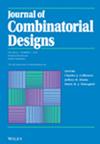下载PDF
{"title":"关于P - G - L (2, q)的3-设计","authors":"Paul Tricot","doi":"10.1002/jcd.22000","DOIUrl":null,"url":null,"abstract":"<p>The group <span></span><math>\n <semantics>\n <mrow>\n \n <mrow>\n <mi>P</mi>\n \n <mi>G</mi>\n \n <mi>L</mi>\n \n <mrow>\n <mo>(</mo>\n \n <mrow>\n <mn>2</mn>\n \n <mo>,</mo>\n \n <mi>q</mi>\n </mrow>\n \n <mo>)</mo>\n </mrow>\n </mrow>\n </mrow>\n </semantics></math> acts 3-transitively on the projective line <span></span><math>\n <semantics>\n <mrow>\n \n <mrow>\n <mi>G</mi>\n \n <mi>F</mi>\n \n <mrow>\n <mo>(</mo>\n \n <mi>q</mi>\n \n <mo>)</mo>\n </mrow>\n \n <mo>∪</mo>\n \n <mrow>\n <mo>{</mo>\n \n <mi>∞</mi>\n \n <mo>}</mo>\n </mrow>\n </mrow>\n </mrow>\n </semantics></math>. Thus, an orbit of its action on the <span></span><math>\n <semantics>\n <mrow>\n \n <mrow>\n <mi>k</mi>\n </mrow>\n </mrow>\n </semantics></math>-subsets of the projective line is the block set of a 3-<span></span><math>\n <semantics>\n <mrow>\n \n <mrow>\n <mrow>\n <mo>(</mo>\n \n <mrow>\n <mi>q</mi>\n \n <mo>+</mo>\n \n <mn>1</mn>\n \n <mo>,</mo>\n \n <mi>k</mi>\n \n <mo>,</mo>\n \n <mi>λ</mi>\n </mrow>\n \n <mo>)</mo>\n </mrow>\n </mrow>\n </mrow>\n </semantics></math> design. We find the parameters of the designs formed by the orbit of a block of the form <span></span><math>\n <semantics>\n <mrow>\n \n <mrow>\n <mrow>\n <mo>〈</mo>\n \n <msup>\n <mi>θ</mi>\n \n <mi>r</mi>\n </msup>\n \n <mo>〉</mo>\n </mrow>\n </mrow>\n </mrow>\n </semantics></math> or <span></span><math>\n <semantics>\n <mrow>\n \n <mrow>\n <mrow>\n <mo>〈</mo>\n \n <msup>\n <mi>θ</mi>\n \n <mi>r</mi>\n </msup>\n \n <mo>〉</mo>\n </mrow>\n \n <mo>∪</mo>\n \n <mrow>\n <mo>{</mo>\n \n <mn>0</mn>\n \n <mo>}</mo>\n </mrow>\n </mrow>\n </mrow>\n </semantics></math>, where <span></span><math>\n <semantics>\n <mrow>\n \n <mrow>\n <mi>θ</mi>\n </mrow>\n </mrow>\n </semantics></math> is a primitive element of <span></span><math>\n <semantics>\n <mrow>\n \n <mrow>\n <mi>G</mi>\n \n <mi>F</mi>\n \n <mrow>\n <mo>(</mo>\n \n <mi>q</mi>\n \n <mo>)</mo>\n </mrow>\n </mrow>\n </mrow>\n </semantics></math>.</p>","PeriodicalId":15389,"journal":{"name":"Journal of Combinatorial Designs","volume":"33 11","pages":"428-432"},"PeriodicalIF":0.8000,"publicationDate":"2025-07-28","publicationTypes":"Journal Article","fieldsOfStudy":null,"isOpenAccess":false,"openAccessPdf":"https://onlinelibrary.wiley.com/doi/epdf/10.1002/jcd.22000","citationCount":"0","resultStr":"{\"title\":\"On 3-Designs From \\n \\n \\n \\n P\\n G\\n L\\n \\n (\\n \\n 2\\n ,\\n q\\n \\n )\",\"authors\":\"Paul Tricot\",\"doi\":\"10.1002/jcd.22000\",\"DOIUrl\":null,\"url\":null,\"abstract\":\"<p>The group <span></span><math>\\n <semantics>\\n <mrow>\\n \\n <mrow>\\n <mi>P</mi>\\n \\n <mi>G</mi>\\n \\n <mi>L</mi>\\n \\n <mrow>\\n <mo>(</mo>\\n \\n <mrow>\\n <mn>2</mn>\\n \\n <mo>,</mo>\\n \\n <mi>q</mi>\\n </mrow>\\n \\n <mo>)</mo>\\n </mrow>\\n </mrow>\\n </mrow>\\n </semantics></math> acts 3-transitively on the projective line <span></span><math>\\n <semantics>\\n <mrow>\\n \\n <mrow>\\n <mi>G</mi>\\n \\n <mi>F</mi>\\n \\n <mrow>\\n <mo>(</mo>\\n \\n <mi>q</mi>\\n \\n <mo>)</mo>\\n </mrow>\\n \\n <mo>∪</mo>\\n \\n <mrow>\\n <mo>{</mo>\\n \\n <mi>∞</mi>\\n \\n <mo>}</mo>\\n </mrow>\\n </mrow>\\n </mrow>\\n </semantics></math>. Thus, an orbit of its action on the <span></span><math>\\n <semantics>\\n <mrow>\\n \\n <mrow>\\n <mi>k</mi>\\n </mrow>\\n </mrow>\\n </semantics></math>-subsets of the projective line is the block set of a 3-<span></span><math>\\n <semantics>\\n <mrow>\\n \\n <mrow>\\n <mrow>\\n <mo>(</mo>\\n \\n <mrow>\\n <mi>q</mi>\\n \\n <mo>+</mo>\\n \\n <mn>1</mn>\\n \\n <mo>,</mo>\\n \\n <mi>k</mi>\\n \\n <mo>,</mo>\\n \\n <mi>λ</mi>\\n </mrow>\\n \\n <mo>)</mo>\\n </mrow>\\n </mrow>\\n </mrow>\\n </semantics></math> design. We find the parameters of the designs formed by the orbit of a block of the form <span></span><math>\\n <semantics>\\n <mrow>\\n \\n <mrow>\\n <mrow>\\n <mo>〈</mo>\\n \\n <msup>\\n <mi>θ</mi>\\n \\n <mi>r</mi>\\n </msup>\\n \\n <mo>〉</mo>\\n </mrow>\\n </mrow>\\n </mrow>\\n </semantics></math> or <span></span><math>\\n <semantics>\\n <mrow>\\n \\n <mrow>\\n <mrow>\\n <mo>〈</mo>\\n \\n <msup>\\n <mi>θ</mi>\\n \\n <mi>r</mi>\\n </msup>\\n \\n <mo>〉</mo>\\n </mrow>\\n \\n <mo>∪</mo>\\n \\n <mrow>\\n <mo>{</mo>\\n \\n <mn>0</mn>\\n \\n <mo>}</mo>\\n </mrow>\\n </mrow>\\n </mrow>\\n </semantics></math>, where <span></span><math>\\n <semantics>\\n <mrow>\\n \\n <mrow>\\n <mi>θ</mi>\\n </mrow>\\n </mrow>\\n </semantics></math> is a primitive element of <span></span><math>\\n <semantics>\\n <mrow>\\n \\n <mrow>\\n <mi>G</mi>\\n \\n <mi>F</mi>\\n \\n <mrow>\\n <mo>(</mo>\\n \\n <mi>q</mi>\\n \\n <mo>)</mo>\\n </mrow>\\n </mrow>\\n </mrow>\\n </semantics></math>.</p>\",\"PeriodicalId\":15389,\"journal\":{\"name\":\"Journal of Combinatorial Designs\",\"volume\":\"33 11\",\"pages\":\"428-432\"},\"PeriodicalIF\":0.8000,\"publicationDate\":\"2025-07-28\",\"publicationTypes\":\"Journal Article\",\"fieldsOfStudy\":null,\"isOpenAccess\":false,\"openAccessPdf\":\"https://onlinelibrary.wiley.com/doi/epdf/10.1002/jcd.22000\",\"citationCount\":\"0\",\"resultStr\":null,\"platform\":\"Semanticscholar\",\"paperid\":null,\"PeriodicalName\":\"Journal of Combinatorial Designs\",\"FirstCategoryId\":\"100\",\"ListUrlMain\":\"https://onlinelibrary.wiley.com/doi/10.1002/jcd.22000\",\"RegionNum\":4,\"RegionCategory\":\"数学\",\"ArticlePicture\":[],\"TitleCN\":null,\"AbstractTextCN\":null,\"PMCID\":null,\"EPubDate\":\"\",\"PubModel\":\"\",\"JCR\":\"Q3\",\"JCRName\":\"MATHEMATICS\",\"Score\":null,\"Total\":0}","platform":"Semanticscholar","paperid":null,"PeriodicalName":"Journal of Combinatorial Designs","FirstCategoryId":"100","ListUrlMain":"https://onlinelibrary.wiley.com/doi/10.1002/jcd.22000","RegionNum":4,"RegionCategory":"数学","ArticlePicture":[],"TitleCN":null,"AbstractTextCN":null,"PMCID":null,"EPubDate":"","PubModel":"","JCR":"Q3","JCRName":"MATHEMATICS","Score":null,"Total":0}
引用次数: 0
引用
批量引用

 求助内容:
求助内容: 应助结果提醒方式:
应助结果提醒方式:


